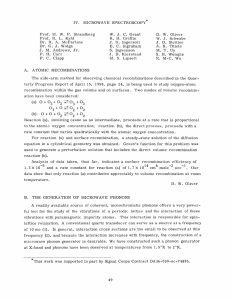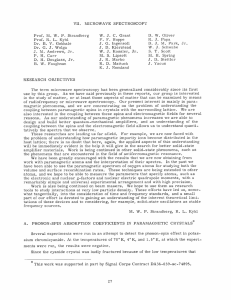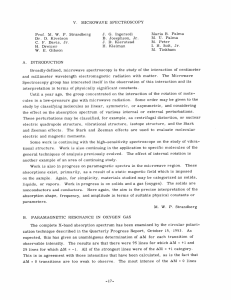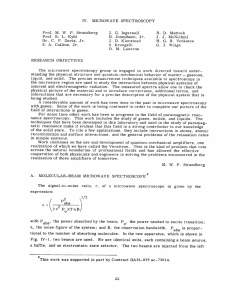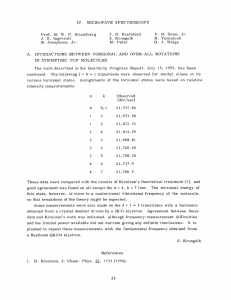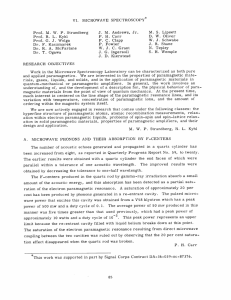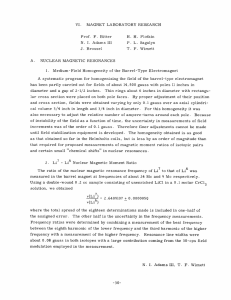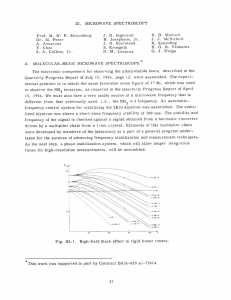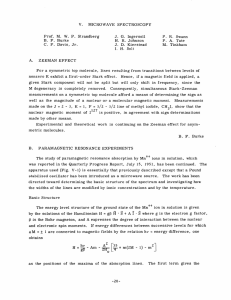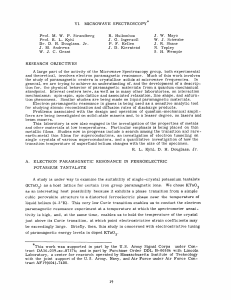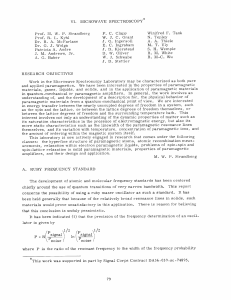III. MICROWAVE SPECTROSCOPY Prof. M. W. P. Strandberg B. Josephson
advertisement
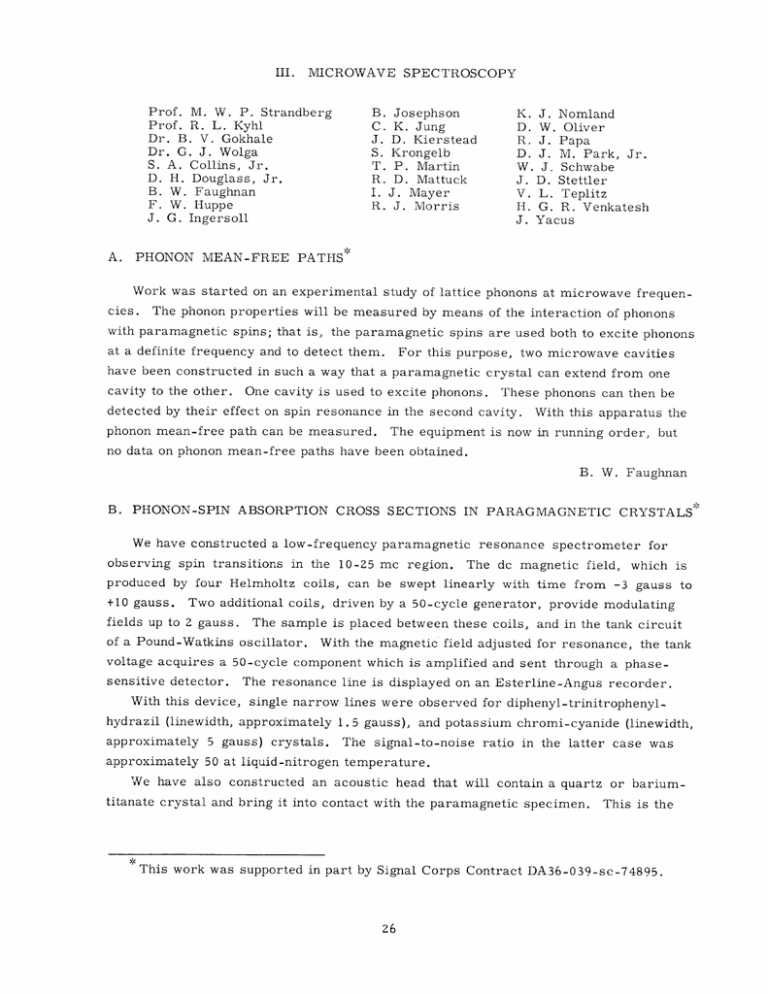
III. MICROWAVE SPECTROSCOPY Prof. M. W. P. Strandberg Prof. R. L. Kyhl Dr. B. V. Gokhale Dr. G. J. Wolga S. A. Collins, Jr. D. H. Douglass, Jr. B. W. Faughnan F. W. Huppe J. G. Ingersoll A. B. Josephson C. K. Jung J. D. Kierstead S. Krongelb T. P. Martin R. D. Mattuck I. J. Mayer R. J. Morris K. D. R. D. W. J. V. H. J. J. Nomland W. Oliver J. Papa J. M. Park, Jr. J. Schwabe D. Stettler L. Teplitz G. R. Venkatesh Yacus PHONON MEAN-FREE PATHS": Work was started on an experimental study of lattice phonons at microwave frequencies. The phonon properties will be measured by means of the interaction of phonons with paramagnetic spins; that is, the paramagnetic spins are used both to excite phonons at a definite frequency and to detect them. For this purpose, two microwave cavities have been constructed in such a way that a paramagnetic crystal can extend from one cavity to the other. One cavity is used to excite phonons. These phonons can then be detected by their effect on spin resonance in the second cavity. With this apparatus the phonon mean-free path can be measured. The equipment is now in running order, but no data on phonon mean-free paths have been obtained. B. W. Faughnan B. PHONON-SPIN ABSORPTION CROSS SECTIONS IN PARAGMAGNETIC CRYSTALS We have constructed a low-frequency paramagnetic resonance spectrometer for observing spin transitions in the 10-25 mc region. The dc magnetic field, which is produced by four Helmholtz coils, can be swept linearly with time from -3 gauss to +10 gauss. Two additional coils, driven by a 50-cycle generator, provide modulating fields up to 2 gauss. The sample is placed between these coils, and in the tank circuit of a Pound-Watkins oscillator. With the magnetic field adjusted for resonance, the tank voltage acquires a 50-cycle component which is amplified and sent through a phasesensitive detector. The resonance line is displayed on an Esterline-Angus recorder. With this device, single narrow lines were observed for diphenyl-trinitrophenylhydrazil (linewidth, approximately 1.5 gauss), and potassium chromi-cyanide (linewidth, approximately 5 gauss) crystals. The signal-to-noise ratio in the latter case was approximately 50 at liquid-nitrogen temperature. We have also constructed an acoustic head that will contain a quartz or bariumtitanate crystal and bring it into contact with the paramagnetic specimen. This is the This work was supported in part by Signal Corps Contract DA36-039-sc-74895. (III. MICROWAVE SPECTROSCOPY) phonon source; it will be driven initially by a signal generator. The electrical charac- teristics of a small barium-titanate crystal that is acoustically resonant at 10 mc have been measured. Several larger quartz crystals have been ordered. R. D. Mattuck C. ATOMIC RECOMBINATION The side-arm method described in the Quarterly Progress Report of April 15, 1958, page 24, has proved to be a practical means for studying oxygen-atom recombination on surfaces. We have shown unambiguously that recombination on quartz is a first-order process. At room temperature, the efficiency of recombination is 3. 2 X 10-4. (Recom- bination efficiency is defined as the portion of oxygen atoms that strike the surface and recombine.) We have also investigated the applicability of paramagnetic resonance to the study of volume recombinations; that is, atoms. recombination that results from collisions between A flow system seems to be the most promising approach to this study. Appli- cation of our data to an approximate analysis of the flow system indicates that recombination obeys the reaction 0 + 0 + 02 - 0 Z + 02 6 X 10 15 cm 6 mole -2 sec -1 , with a constant rate of approximately . A more exact treatment of the flow system is being studied. S. Krongelb D. SPECTROSCOPY OF FREE ATOMS AND RADICALS A program for studying the free angular momentum states (of atoms and free radi- cals) in a magnetic field has been initiated. In general terms, the method of paramagneticresonance microwave spectroscopy will be used to examine atomic ground states with net angular momentum in magnetic fields of 3000-5000 gauss, a region in which accurate measurements of atomic g values can be made. If the free atomic ground state is unavailable because of chemical activity or bonding, such as occurs in N., 0 , H2, Clz' and so forth, the free atomic states can be created through dissociation in a microwave gaseous discharge. The attractiveness of the method of paramagnetic resonance stems from the availability of high detection sensitivity, which allows short-lifetime, freeradical work to be pursued, and from the simplicity of the experiment, which is the same for all substances. With the standardized experiment it is feasible to systematically examine structurally related atoms. Since our early work with atomic oxygen (1), the experimental apparatus has been improved in connection with the work on recombination phenomena in oxygen. Recently, in trial experiments, the hyperfine structures of atomic hydrogen and atomic nitrogen were observed. The observed X-band transitions were between adjacent M.J states with (III. MICROWAVE SPECTROSCOPY) the same M. value. 1 The method is being extended to liquids that have significant vapor pressure. Bro- mine was chosen as the first working substance because it has high vapor pressure, and its hyperfine interactions are known from low-field, molecular-beam work. The energy levels in magnetic fields from 1500 gauss to 12, 000 gauss were calculated from the secular equation by numerical methods, and the mixed-state wave functions were calculated from perturbation theory as a function of magnetic field. A completely closed bromine- discharge sample tube was designed and is being constructed. Pumping action is created by establishing a pressure gradient through temperature control of the bromine vaporpressure source and establishing a liquid-nitrogen sink for the bromine at the other end of the tube. A constricted section near the bromine source allows a reduction of working pressure to approximately 1 mm Hg. The design specifications have a flow velocity of 2 X 103 cm/sec, which corresponds to 1019 molecules/second. For 10 per cent dissoci- ation of molecular bromine into ground-state atoms, this will allow approximately 5 X 1015 spins to be observed simultaneously in one of the hyperfine states. ordinarily more than sufficient for observation in these experiments. charge of 16 gm of Br 2, This is With a working four hours of continuous experimentation can be carried out before redistillation is necessary. G. J. Wolga References 1. G. J. Wolga, Quarterly Progress Report, Research Laboratory of Electronics, M.I.T., July 15, 1956, pp. 12-13. E. ANTIFERROMAGNETIC RESONANCE Antiferromagnetic resonance has been observed on manganese chloride at 9000 mc. There are several interesting features: 1. On a reduced temperature scale the curves look similar to the curves obtained by Dayhoff (1)on chromium sesquioxide. Only one orientation has been looked at thus far, but the fact that the low-temperature branch was observed, as well as the one near the N6el temperature, indicates that the spin directions are probably normal to the C-axis. 2. The apparent Neel temperature is approximately 2. 10 K. 3. There is nothing, at present, that indicates two transition temperatures. lar data will be taken to check these observations. Angu- The same experiments will then be carried out at 35, 000 mc. Magnetic resonance has also been observed on polycrystalline ferric chloride at 9000 mc, which stays paramagnetic down to 2. 430 K. At this temperature, it deviates (III. MICROWAVE SPECTROSCOPY) abruptly from paramagnetic behavior in a way that does not appear to be antiferromagnetic. Single crystals will be grown so that further experimentation can be carried out. D. H. Douglass, Jr. References 1. E. S. Dayhoff, Antiferromagnetic resonance in Cr203, Phys. Rev. 107, 84 (1957); see Fig. 4, p. 88.
